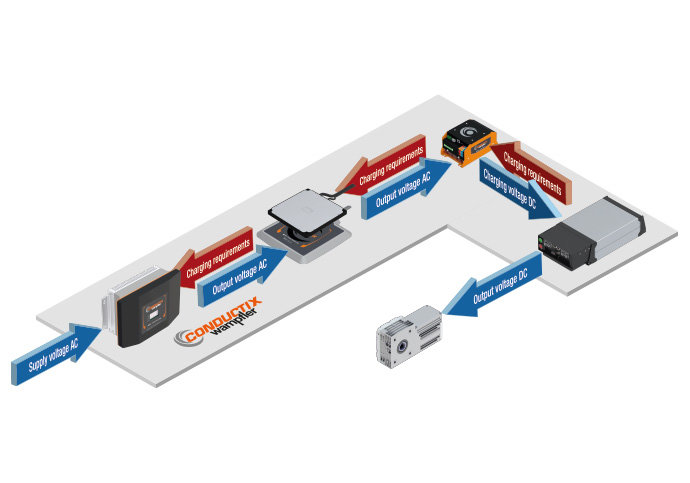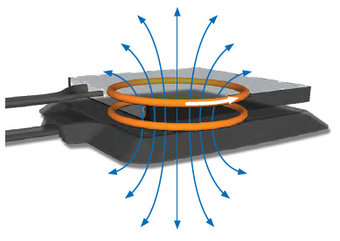Recommend
Remove File
Remove document <span id="remove-document-name"></span> from <span id="remove-cart-name"></span>?

In September 2021, Conductix-Wampfler, one of the world's leading manufacturers of energy and data management systems for mobile equipment, introduces the Wireless Charger 3.0, a solution for charging energy storage devices that relies on inductive power transfer to enable contactless, automated battery charging.
Automated, driverless vehicles are becoming increasingly important in modern production and logistics. At the same time, the rest periods for the vehicles are decreasing, as they are continuously used due to globally growing e-commerce and faster production cycles. Here, the application of opportunity charging implemented in the operating processes offers a modern solution for using even small time windows for wireless, inductive charging, for example while waiting during loading. In addition, the use of smaller batteries is possible and the service life of the cells is increased by quicker and more frequent charging processes putting less strain on the cells. The Wireless Charger 3.0 from Conduxtix-Wampfler consists of only four compact core components. The system can be mounted vertically and horizontally and thus flexibly integrated into already existing production or warehouse processes.
Intelligent battery management, sophisticated design
Centerpiece of the Wireless Charger 3.0 is the stationary IPS (Inductive Power Supply), which converts the mains voltage into a higher-frequency alternating voltage. The magnetic field thus generated in the ISP (Inductive Stationary Pad), which is mounted stationary in the floor or on the wall, hits the IMP (Inductive Mobile Pad) contact-free, which is located on the vehicle, converting the magnetic field back into current. The electric current is converted to a DC voltage in the coupled electronic MPU (Mobile Power Unit) charging the battery. This system has numerous advantages: "The IPS is equipped with a status display and takes care of the demand-oriented energy supply. If the battery is charged intermediately on a regular basis and according to demand, possibly harmful minimum and maximum charging states are avoided" explains Mathias Wechlin, Product Manager at Conductix-Wampfler and adds: "The Wireless Charger 3.0 offers freedom from mechanical wear and is, in this respect, maintenance-free. There are no open contact surfaces on the coils or pads; instead, they are fully encapsulated, thus safe from contact, and possess enormous robustness against environmental influences." By eliminating mechanical abrasion, wireless chargers can also be used in areas that are generally sensitive to contamination, such as clean production areas in the pharmaceutical or food industries. High efficiency and the use of state-of-the-art electronic components make the Wireless Charger 3.0 a modern solution for the automated logistics of tomorrow.
The WirelessCharger 3.0 is an industrial, wireless charging system, based on inductive coupling which provides automated contactless, fully intervention-free, and efficient battery charging for various kinds of vehicles, i.e. all kinds of Automated Guide Vehicles (AGVs), Autonomous Mobile Robots (AMRs / Cobots) or industrial trucks and forklifts.
Optimized, Efficient Charging
Using Lithium batteries, the charging process is optimized by a constant interaction between the onboard battery management system (BMS) and the Inductive Power Supply (IPS). The track supply only provides the instantaneously required power.
In contrast to conventional charging systems – conductive charging contacts and “plugged” inductive systems – the WirelessCharger 3.0 does not use any plugs or paddles and is fully intervention free.
Positioning the vehicle roughly over the Inductive Stationary Pad (ISP), the stationary coil is the only requirement. Charging can be fully automated.
Providing in-process charging automation capability, Wireless Chargers are ideal to apply opportunity charging. Short and frequent contactless charging intervals do reduce the thermal load on batteries, do extend their lifetime and make reduced battery capacities possible. Wirelss charging becomes a process integrated doing, there are no extended dead times for charging or travelling times to designated charging locations or even swapping batteries.

Safety Aspects
The geometry of the Conductix-Wampfler WirelessCharger 3.0 enables the Inductive Stationary Pad (ISP) and Inductive Mobile Pad (IMP) to contain the magnetic field mostly in the air gap between them.
No accidental switch on by different safety precautions, such as validations, pairing, defined charging orientation. When the vehicle is off the charging position, the track supply de-energizes the Inductive Stationary Pad, same when communication is not available.
By the nature of the power transfer means, there are no exposed contact surfaces. Pads are completely encapsulated and provide a high level IP-rating.
The Wireless Chargers are always following provided or pre-defined requirements, so the vehicle side determines the rate of power transfer. Typically with Lithium batteries they exclusively follow the charging requirements provided to the Mobile Power Unit (MPU).
System status provided to stationary and mobile control units through CAN and/or Ethernet interfaces. Ease of state recognition by the display on the Inductive Power Supply (IPS) and the halo light effect.
By design, the output is current limited. Onboard components are galvanically separated from the stationary components.
Communication between the mobile and the stationary side of the wireless charger by the means of inductive communication is unaffected by radio based communication, i.e. WiFi, used close by.
Operating Principle
Each wireless charger system consists of two parts, primary/stationary and secondary/mobile, which are magnetically coupled, similar to a conventional transformer. The primary or stationary side consists of an Inductive Power Supply (IPS) and an Inductive Stationary Pad (ISP). The secondary, or mobile vehicle side, consists of an Inductive Mobile Pad (IMP) and a Mobile Power Unity (MPU), installed onboard a vehicle.
Unlike a conventional transformer, where primary coil and secondary coil are mechanically coupled, the WirelessCharger 3.0 is a loosely coupled system operational with an air-gap.

Opportunity Charging / In-process Charging
Opportunity Charging or in-process charging means the use of available time slots during operations. Typically, these are short but frequent stops. Which means you never recharge the battery completely; you just refill it to a certain extend.
The WirelessCharger 3.0 is a system which enables vehicles such as Automated Guided Vehicles (AGVs) to operate fully on this principle on an ideal basis.
A minimal onboard energy storage, enough to reach the next contactless charging opportunity, becomes practically sufficient to operate AGVs.
This offers various practical scenarios: